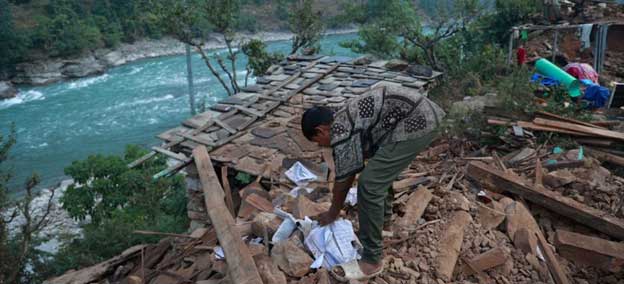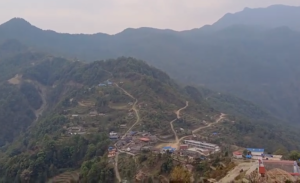Impact of Climate Change on a Biodiversity Hot Spot

Simone Galimberti —-
If there is a place where the interlinkages and dependencies between the effects of climate warming and biodiversity loss are clearly at display, it’s Nepal. There is clear evidence on the impact of climate change on the country’s ecosystem considering the fact that Nepal is an important biodiversity hotspot.
Climate change and biodiversity loss, if unchecked, can activate mutually devastating loops of devastation that hardly can be offset by any plan and strategy. The only solution is a much stronger level of coordination and policy alignment, not only within countries like Nepal but also regionally.
This is one of the reasons why scientists and experts working on the upcoming IPBES Next Assessment that attempts to study the interlinkages among biodiversity, water, food and health with actions to achieve the Agenda 2030 while combating climate change, chose Kathmandu for their latest summit.
The linkages between climate warming and biodiversity loss were also one of the key hallmarks of COP 28 in the UAE where, for the first time, biodiversity preservation was recognized as a paramount factor to fight climate change.
In the first Global Stocktake, the main outcome document of the COP 28, there has been a strong reference to the implementation of Kunming-Montreal Global Biodiversity Framework (KMGBF).
In practice, for nations, it means to work hard to converge the climate and biodiversity agendas as the new cycle of Nationally Determined Contributions, the key mitigations plans prepared by each nation party to the Paris Agreement, will also have to include elements related to biodiversity.
This can be proved to be challenging considering also the efforts that a country like Nepal must also put to implement its adaptation plans.
Coordination and alignment between the mitigation and adaptation is at least provided in what should be as the country’s “master plan” to fight climate change, its National Climate Change Policy whose latest iteration was approved in 2019.
It is a document that identified 12 areas, from agriculture and food security to forests, biodiversity and watershed conservation to water resources and energies to rural and urban settlement, tourism and transportation, just to mention few.
Yet ensuring such policy level harmonization is going to be daunting, considering the traditional fragmentations that characterize policy making in Nepal.
At governance level, there are two key mechanisms that have not been fully harnessed.
The first one is the apex body in matter of climate action, the Climate Change Council that is chaired by the Prime Minister.
Its convenings have been not only rare but also mostly symbolic and devoid of substantial decisions. If you think about the challenges faced by Nepal, this should be the most important bureaucratic body at policy level but you seldom hear news about it.
The second instrument at disposal is the Multistakeholder Climate Change Initiative Coordination Committee that should bring together the best minds in the field. So far, what potentially could be a great platform for dialogue has been wasted.
The fact that the Government has formally included the Nepalese Youth for Climate Action as a constituency, does not absolve the authorities from being lacking in terms of proactively enabling and putting in place a structured and formal mechanism in matter of climate.
The latest IPBES Global Biodiversity Report, published in 2019, confirmed, once again, that unequivocally “nature and its vital contributions to people, which together embody biodiversity and ecosystem, functions and services, are deteriorating worldwide”.
“Nature across most of the globe has now been significantly altered by multiple human drivers, with the great majority of indicators of ecosystems and biodiversity showing rapid decline”.
The latest report by the World Meteorological Organization could not be even more daunting, once again, proving we are living in the hottest times ever. The key message from the IPBES Next Assessment’s meeting held in Kathmandu was equally daunting and unequivocal, declaring that the whole Hindu Kush Himalaya’s biosphere is “on the brink’.
Another event organized by ICIMOD, the international conference on Climate and Environmental Change Impacts on the Indus Basin Waters, stressed out the essentiality of coordination.
Highlighting key findings of a series of new reports focused on ensuring effective “integrated river basin management”, this gathering underlined how climate change becomes the “urgent catalyst for collaboration over three key river basins in Asia, the Indus, the Ganga, and the Brahmaputra”.
In a press release issued by ICIMOD, Alan Nicol from the International Water Management Institute that collaborated in the writing of the reports, affirmed that the “level of challenges facing the Indus Basin call for collective action across the basin”.
How can such coordination be turned into reality within Nepal and within the whole South Asia?
At national level, climate action should permeate and be embedded in each sphere of policy making. Mechanisms like Climate Change Council and Multistakeholder Climate Change Initiative Coordination Committee must be seriously and meaningfully activated and empowered.
Considering the deep connections between climate and biodiversity, the latter, normally overshadowed by the former domain, should also be included or at least taken into account when the decision makers deliberate on climate related issues.
Enhancing coordination exponentially must be a priority but not only at central level especially in a federal country like Nepal.
Though federalism is still very much a work in progress and where the seven provinces still lack powers and real autonomy, it remains paramount to empower local bodies as well.
Imagine the immense work that must be done in the field of mitigation and adaptation, the two key areas of action within the climate agenda alone. Only in relation to adaptation, the National Adaptation Plan 2021- 2050 aims to mobilize the staggering figure of US$ 47.4 billion of which Nepal will only contribute US$ 1.5 billion.
In the recent “National Dialogue on Climate Change” organized by Municipality Association of Nepal made it clear that local bodies must necessarily be empowered to fight climate change.
A case study prepared by Prakriti Resource Center, one of the most renown climate focused organizations in Nepal, revealed the failure in effectively implementing the Local Adaptation Plans for Actions (LAPA), despite being revised 2019 to reflect the new federal governance of the country.
Local governments should also be at the vanguard of mitigation efforts but reality tells us a different story.
A limited and distorted focus of mitigation mainly in terms of production of hydropower energy, a federal competence, compounded by lack of resources, is currently disempowering local governments from taking action.
Frustrating and disappointing remains the work in the field of biodiversity. Both centrally and locally, there is a lack of urgency here even though the country can count with some success story in local forest preservations by local communities.
Yet, also on this case, Nepal is at risk of falling into a complacence trap without additional strategic thinking.
There is the need not only of coming up with a new, revamped national strategy but it is also essential to evaluate the implementation of the latest National Biodiversity Strategy and Action Plan 2014 -2020, especially in relation to design and execution of Local Biodiversity Strategy and Action Plans.
But, as we know, coordination and alignment by overcoming silos approaches, should not stop within the national borders.
Here there is an opportunity to put together some sort of regional cooperative framework that, as we saw, are strongly encouraged by the experts. New synergetic impetus at national level in both climate and biodiversity areas could spur the country to also take the initiative regionally.
It can happen in a way that could, at least revamp and give some scope to the almost defuncted South Asia Association of Regional Cooperation, SAARC. Cooperation in South Asia in a novel integrated fashion that links and combines climate efforts and biodiversity preservation, is a must.
Geopolitical rivalries cannot impede it even if, it means, in practice, effectively sidelining the SAARC.
What all this could mean for Nepal?A joint, combined approach to preserve nature and fight climate warming, together with a revamped attention on pollution and sustainable consumption habits, other two essential aspects that must be tackled in the years to come with urgency, could bring about not only a better and more effective forms of governance in the country.
It could also enable Nepal to become a trailblazer in revamping regional cooperation, pragmatically in areas where traditional rivalries must be set aside for the sake of South Asian citizens’ common good.
A good way to start is to at least to get the “homework” well done in the country, preparing itself on how integrating biodiversity in its negotiations for the next climate COP 29 in Azerbaijan but also be serious about the upcoming biodiversity COP 16 in Colombia.-IPS UN Bureau
Simone Galimberti is co-founder of Engage a local NGO promoting partnership and cooperation for youth living in disability and of The Good Leadership, a new initiative promoting character leadership and expertise among youth.
17 April 2024
Photo : A boy sifts through the rubble of his earthquake-hit home in Rukum (West), Nepal, in November 2023. Credit: UNICEF/ Laxmi Prasad Ngakhus














